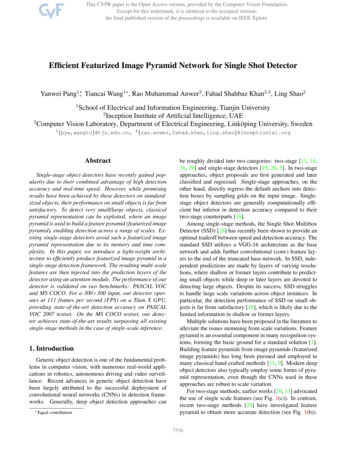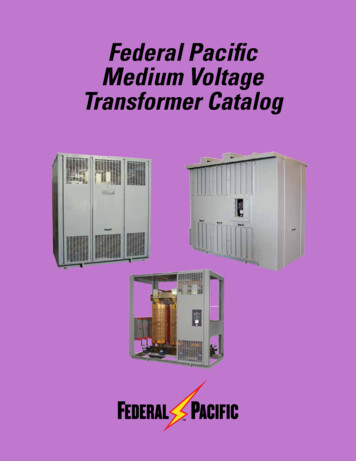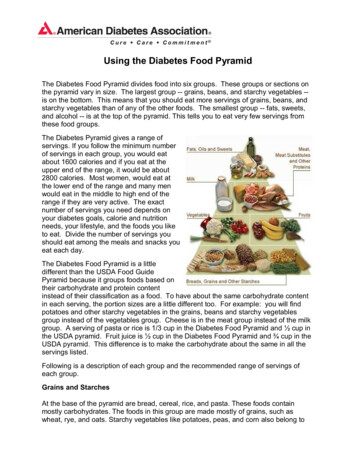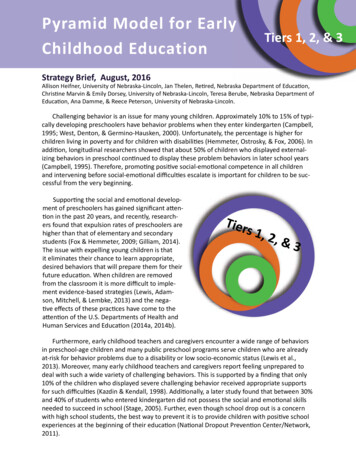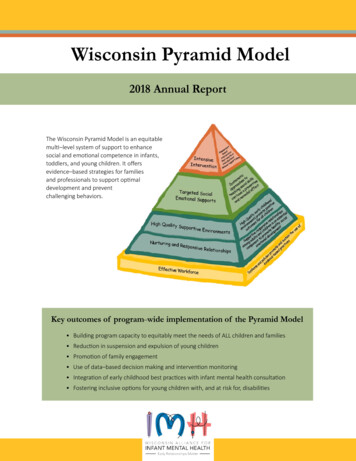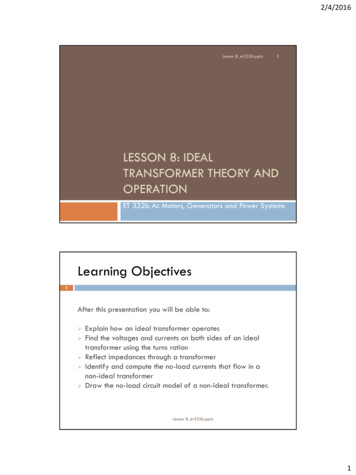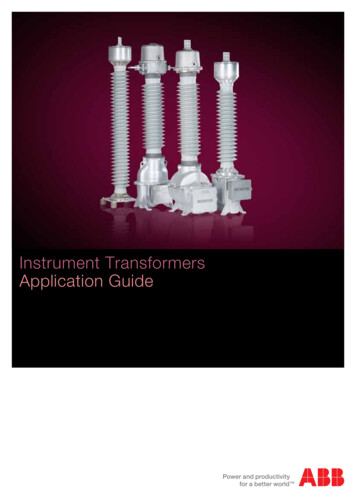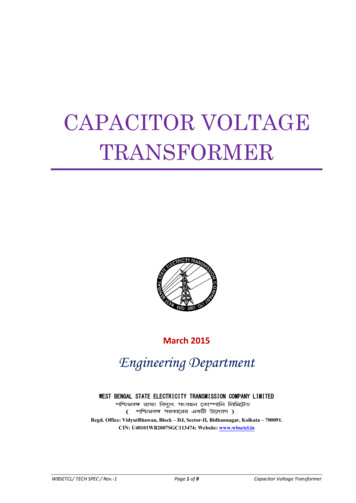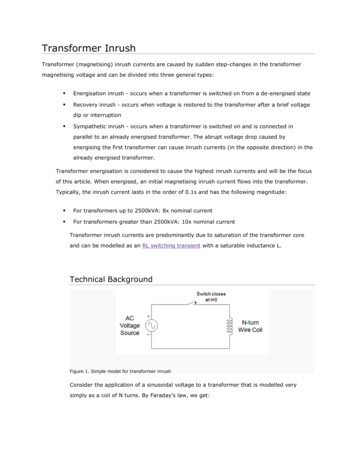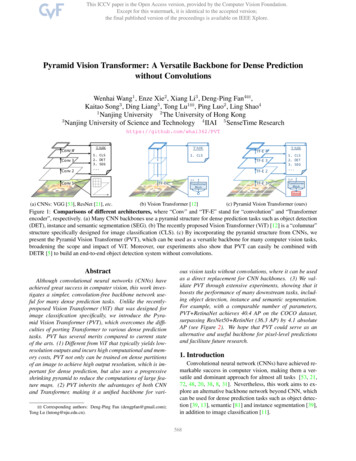
Transcription
Pyramid Vision Transformer: A Versatile Backbone for Dense Predictionwithout ConvolutionsWenhai Wang1 , Enze Xie2 , Xiang Li3 , Deng-Ping Fan4B ,Kaitao Song3 , Ding Liang5 , Tong Lu1B , Ping Luo2 , Ling Shao41Nanjing University 2 The University of Hong Kong3Nanjing University of Science and Technology 4 IIAI 5 SenseTime Researchhttps://github.com/whai362/PVTConv 4Conv 3Conv 2TASKTASK1. CLS2. DET3. SEG.1. CLSTF-E 3TF-E 2! TF-EConv 1TF-E 4TransformerBlockTF-E 1TASK1. CLS2. DET3. SEG.!! TransformerBlockShrink(a) CNNs: VGG [53], ResNet [21], etc.(b) Vision Transformer [12](c) Pyramid Vision Transformer (ours)Figure 1: Comparisons of different architectures, where “Conv” and “TF-E” stand for “convolution” and “Transformerencoder”, respectively. (a) Many CNN backbones use a pyramid structure for dense prediction tasks such as object detection(DET), instance and semantic segmentation (SEG). (b) The recently proposed Vision Transformer (ViT) [12] is a “columnar”structure specifically designed for image classification (CLS). (c) By incorporating the pyramid structure from CNNs, wepresent the Pyramid Vision Transformer (PVT), which can be used as a versatile backbone for many computer vision tasks,broadening the scope and impact of ViT. Moreover, our experiments also show that PVT can easily be combined withDETR [5] to build an end-to-end object detection system without convolutions.AbstractAlthough convolutional neural networks (CNNs) haveachieved great success in computer vision, this work investigates a simpler, convolution-free backbone network useful for many dense prediction tasks. Unlike the recentlyproposed Vision Transformer (ViT) that was designed forimage classification specifically, we introduce the Pyramid Vision Transformer (PVT), which overcomes the difficulties of porting Transformer to various dense predictiontasks. PVT has several merits compared to current stateof the arts. (1) Different from ViT that typically yields lowresolution outputs and incurs high computational and memory costs, PVT not only can be trained on dense partitionsof an image to achieve high output resolution, which is important for dense prediction, but also uses a progressiveshrinking pyramid to reduce the computations of large feature maps. (2) PVT inherits the advantages of both CNNand Transformer, making it a unified backbone for variB Corresponding authors: Deng-Ping Fan (dengpfan@gmail.com);Tong Lu (lutong@nju.edu.cn).ous vision tasks without convolutions, where it can be usedas a direct replacement for CNN backbones. (3) We validate PVT through extensive experiments, showing that itboosts the performance of many downstream tasks, including object detection, instance and semantic segmentation.For example, with a comparable number of parameters,PVT RetinaNet achieves 40.4 AP on the COCO dataset,surpassing ResNet50 RetinNet (36.3 AP) by 4.1 absoluteAP (see Figure 2). We hope that PVT could serve as analternative and useful backbone for pixel-level predictionsand facilitate future research.1. IntroductionConvolutional neural network (CNNs) have achieved remarkable success in computer vision, making them a versatile and dominant approach for almost all tasks [53, 21,72, 48, 20, 38, 8, 31]. Nevertheless, this work aims to explore an alternative backbone network beyond CNN, whichcan be used for dense prediction tasks such as object detection [39, 13], semantic [81] and instance segmentation [39],in addition to image classification [11].1568
44PVT-MCOCO BBox AP -64x4dX101-32x4dBackbone#Param (M)R101R18 [21]21.3PVT-T (ours)23.0R50 [21]37.7PVT-S (ours)34.2R101 [21]56.756.4X101-32x4d [72]ViT-S/32 [12]60.8ViT-S/32PVT-M (ours)53.9X101-64x4d [72]95.5PVT-L 41.941.042.6100 110 120 130#Parameter (M)Figure 2: Performance comparison on COCO val2017of different backbones using RetinaNet for object detection, where “T”, “S”, “M” and “L” denote our PVT modelswith tiny, small, medium and large size. We see that whenthe number of parameters among different models are comparable, PVT variants significantly outperform their corresponding counterparts such as ResNets (R) [21], ResNeXts(X) [72], and ViT [12].Inspired by the success of Transformer [63] in natural language processing, many researchers have exploredits application in computer vision. For example, someworks [5, 82, 71, 55, 23, 41] model the vision task as a dictionary lookup problem with learnable queries, and use theTransformer decoder as a task-specific head on top of theCNN backbone. Although some prior arts have also incorporated attention modules [69, 47, 78] into CNNs, as faras we know, exploring a clean and convolution-free Transformer backbone to address dense prediction tasks in computer vision is rarely studied.Recently, Dosovitskiy et al. [12] introduced the VisionTransformer (ViT) for image classification. This is an interesting and meaningful attempt to replace the CNN backbone with a convolution-free model. As shown in Figure 1(b), ViT has a columnar structure with coarse image patchesas input.1 Although ViT is applicable to image classification, it is challenging to directly adapt it to pixel-leveldense predictions such as object detection and segmentation, because (1) its output feature map is single-scale andlow-resolution, and (2) its computational and memory costsare relatively high even for common input image sizes (e.g.,shorter edge of 800 pixels in the COCO benchmark [39]).To address the above limitations, this work proposes apure Transformer backbone, termed Pyramid Vision Trans1 Dueto resource constraints, ViT cannot use fine-grained imagepatches (e.g., 4 4 pixels per patch) as input, instead only receive coarsepatches (e.g., 32 32 pixels per patch) as input, which leads to its low output resolution (e.g., 32-stride).former (PVT), which can serve as an alternative to the CNNbackbone in many downstream tasks, including image-levelprediction as well as pixel-level dense predictions. Specifically, as illustrated in Figure 1 (c), our PVT overcomes thedifficulties of the conventional Transformer by (1) takingfine-grained image patches (i.e., 4 4 pixels per patch) as input to learn high-resolution representation, which is essential for dense prediction tasks; (2) introducing a progressiveshrinking pyramid to reduce the sequence length of Transformer as the network deepens, significantly reducing thecomputational cost, and (3) adopting a spatial-reduction attention (SRA) layer to further reduce the resource consumption when learning high-resolution features.Overall, the proposed PVT possesses the following merits. Firstly, compared to the traditional CNN backbones(see Figure 1 (a)), which have local receptive fields that increase with the network depth, our PVT always produces aglobal receptive field, which is more suitable for detectionand segmentation. Secondly, compared to ViT (see Figure 1 (b)), thanks to its advanced pyramid structure, ourmethod can more easily be plugged into many representative dense prediction pipelines, e.g., RetinaNet [38] andMask R-CNN [20]. Thirdly, we can build a convolutionfree pipeline by combining our PVT with other task-specificTransformer decoders, such as PVT DETR [5] for object detection. To our knowledge, this is the first entirelyconvolution-free object detection pipeline.Our main contributions are as follows:(1) We propose Pyramid Vision Transformer (PVT),which is the first pure Transformer backbone designed forvarious pixel-level dense prediction tasks. Combining ourPVT and DETR, we can construct an end-to-end object detection system without convolutions and handcrafted components such as dense anchors and non-maximum suppression (NMS).(2) We overcome many difficulties when porting Transformer to dense predictions, by designing a progressiveshrinking pyramid and a spatial-reduction attention (SRA).These are able to reduce the resource consumption of Transformer, making PVT flexible to learning multi-scale andhigh-resolution features.(3) We evaluate the proposed PVT on several different tasks, including image classification, object detection,instance and semantic segmentation, and compare it withpopular ResNets [21] and ResNeXts [72]. As presentedin Figure 2, our PVT with different parameter scales canconsistently archived improved performance compared tothe prior arts. For example, under a comparable numberof parameters, using RetinaNet [38] for object detection,PVT-Small achieves 40.4 AP on COCO val2017, outperforming ResNet50 by 4.1 points (40.4 vs. 36.3). Moreover,PVT-Large achieves 42.6 AP, which is 1.6 points better thanResNeXt101-64x4d, with 30% less parameters.569
2. Related Work2.1. CNN BackbonesCNNs are the work-horses of deep neural networks in visual recognition. The standard CNN was first introduced in[33] to distinguish handwritten numbers. The model contains convolutional kernels with a certain receptive fieldthat captures favorable visual context. To provide translation equivariance, the weights of convolutional kernelsare shared over the entire image space. More recently,with the rapid development of the computational resources(e.g., GPU), the successful training of stacked convolutionalblocks [32, 53] on large-scale image classification datasets(e.g., ImageNet [50]) has become possible. For instance,GoogLeNet [58] demonstrated that a convolutional operator containing multiple kernel paths can achieve very competitive performance. The effectiveness of a multi-pathconvolutional block was further validated in Inception series [59, 57], ResNeXt [72], DPN [9], MixNet [64] andSKNet [35]. Further, ResNet [21] introduced skip connections into the convolutional block, making it possible to create/train very deep networks and obtaining impressive results in the field of computer vision. DenseNet [24] introduced a densely connected topology, which connects eachconvolutional block to all previous blocks. More recent advances can be found in recent survey/review papers [30, 52].Unlike the full-blown CNNs, the vision Transformerbackbone is still in its early stage of development. In thiswork, we try to extend the scope of Vision Transformer bydesigning a new versatile Transformer backbone suitablefor most vision tasks.2.2. Dense Prediction TasksPreliminary. The dense prediction task aims to performpixel-level classification or regression on a feature map.Object detection and semantic segmentation are two representative dense prediction tasks.Object Detection.In the era of deep learning,CNNs [33] have become the dominant framework for object detection, which includes single-stage detectors (e.g.,SSD [42], RetinaNet [38], FCOS [61], GFL [36, 34], PolarMask [70] and OneNet [54]) and multi-stage detectors(Faster R-CNN [48], Mask R-CNN [20], Cascade R-CNN[4] and Sparse R-CNN [56]). Most of these popular object detectors are built on high-resolution or multi-scale feature maps to obtain good detection performance. Recently,DETR [5] and deformable DETR [82] combined the CNNbackbone and the Transformer decoder to build an endto-end object detector. Likewise, they also require highresolution or multi-scale feature maps for accurate objectdetection.Semantic Segmentation. CNNs also play an importantrole in semantic segmentation. In the early stages, FCN[43] introduced a fully convolutional architecture to generate a spatial segmentation map for a given image of anysize. After that, the deconvolution operation was introducedby Noh et al. [46] and achieved impressive performance onthe PASCAL VOC 2012 dataset [51]. Inspired by FCN, UNet [49] was proposed for the medical image segmentationdomain specifically, bridging the information flow betweencorresponding low-level and high-level feature maps of thesame spatial sizes. To explore richer global context representation, Zhao et al. [79] designed a pyramid poolingmodule over various pooling scales, and Kirillov et al. [31]developed a lightweight segmentation head termed Semantic FPN, based on FPN [37]. Finally, the DeepLab family[7, 40] applies dilated convolutions to enlarge the receptivefield while maintaining the feature map resolution. Similarto object detection methods, semantic segmentation modelsalso rely on high-resolution or multi-scale feature maps.2.3. Self-Attention and Transformer in VisionAs convolutional filter weights are usually fixed aftertraining, they cannot be dynamically adapted to differentinputs. Many methods have been proposed to alleviate thisproblem using dynamic filters [29] or self-attention operations [63]. The non-local block [69] attempts to modellong-range dependencies in both space and time, whichhas been shown beneficial for accurate video classification. However, despite its success, the non-local operator suffers from the high computational and memory costs.Criss-cross [25] further reduces the complexity by generating sparse attention maps through a criss-cross path.Ramachandran et al. [47] proposed the stand-alone selfattention to replace convolutional layers with local selfattention units. AANet [3] achieves competitive resultswhen combining the self-attention and convolutional operations. LambdaNetworks [2] uses the lambda layer, an efficient self-attention to replace the convolution in the CNN.DETR [5] utilizes the Transformer decoder to model object detection as an end-to-end dictionary lookup problemwith learnable queries, successfully removing the need forhandcrafted processes such as NMS. Based on DETR, deformable DETR [82] further adopts a deformable attention layer to focus on a sparse set of contextual elements,obtaining faster convergence and better performance. Recently, Vision Transformer (ViT) [12] employs a pureTransformer [63] model for image classification by treating an image as a sequence of patches. DeiT [62] furtherextends ViT using a novel distillation approach. Differentfrom previous models, this work introduces the pyramidstructure into Transformer to present a pure Transformerbackbone for dense prediction tasks, rather than a taskspecific head or an image classification model.3. Pyramid Vision Transformer (PVT)3.1. Overall ArchitectureOur goal is to introduce the pyramid structure into theTransformer framework, so that it can generate multi-scale570
𝐻 𝑊 3𝐹!:𝐻 𝑊 𝐶!4 4Stage 1𝐹" :𝐻 𝑊 𝐶"8 8𝐹# :Stage 2𝐻 𝑊 𝐶#16 16Stage 3𝐹 :𝐻 𝑊 𝐶32 32 Stage 4EncoderPatch EmbEncoderPatch EmbEncoderPatch EmbEncoderPatch EmbStage "# 𝐶!𝑃! SpacialReductionFeature Map𝐻!"# 𝑊!"# 𝑃!𝑃! (𝑃! 𝐶!"#)PatchEmbeddingReshapeNormElement-wise AddNormLinearPosition EmbeddingReshape𝐻!"# 𝑊!"# 𝑃!𝑃! 𝐶!Transformer Encoder (𝐿% )Figure 3: Overall architecture of Pyramid Vision Transformer (PVT). The entire model is divided into four stages, eachof which is comprised of a patch embedding layer and a Li -layer Transformer encoder. Following a pyramid structure, theoutput resolution of the four stages progressively shrinks from high (4-stride) to low (32-stride).feature maps for dense prediction tasks (e.g., object detection and semantic segmentation). An overview of PVT isdepicted in Figure 3. Similar to CNN backbones [21], ourmethod has four stages that generate feature maps of different scales. All stages share a similar architecture, whichconsists of a patch embedding layer and Li Transformer encoder layers.In the first stage, given an input image of size H W 3,2we first divide it into HW42 patches, each of size 4 4 3.Then, we feed the flattened patches to a linear projectionand obtain embedded patches of size HW42 C1 . After that,the embedded patches along with a position embedding arepassed through a Transformer encoder with L1 layers, andWthe output is reshaped to a feature map F1 of size H4 4 C1 .In the same way, using the feature map from the previous stage as input, we obtain the following feature maps:F2 , F3 , and F4 , whose strides are 8, 16, and 32 pixelswith respect to the input image. With the feature pyramid{F1 , F2 , F3 , F4 }, our method can be easily applied to mostdownstream tasks, including image classification, object detection, and semantic segmentation.then each patch is flatten and projected to a Ci -dimensionalembedding. After the linear projection, the shape of the embedded patches can be viewed as HPi i 1 WPi i 1 Ci , wherethe height and width are Pi times smaller than the input.In this way, we can flexibly adjust the scale of the featuremap in each stage, making it possible to construct a featurepyramid for Transformer.3.2. Feature Pyramid for Transformer3.3. Transformer EncoderUnlike CNN backbone networks [53, 21], which usedifferent convolutional strides to obtain multi-scale featuremaps, our PVT uses a progressive shrinking strategy to control the scale of feature maps by patch embedding layers.Here, we denote the patch size of the i-th stage as Pi . Atthe beginning of stage i, we first evenly divide the input feai 1ture map Fi 1 RHi 1 Wi 1 Ci 1 into Hi P1 Wpatches, and2The Transformer encoder in the stage i has Li encoderlayers, each of which is composed of an attention layerand a feed-forward layer [63]. Since PVT needs to processhigh-resolution (e.g., 4-stride) feature maps, we propose aspatial-reduction attention (SRA) layer to replace the traditional multi-head attention (MHA) layer [63] in the encoder.Similar to MHA, our SRA receives a query Q, a key K,and a value V as input, and outputs a refined feature. Thedifference is that our SRA reduces the spatial scale of Ki2 Asdone for ResNet, we keep the highest resolution of our output feature map at tialReductionQKVMulti-Head Attention𝐻! 𝑊! 𝐶!𝑅"!QKV (𝐻! 𝑊! ) 𝐶!Spatial-Reduction Attention (ours)Figure 4: Multi-head attention (MHA) vs. spatialreduction attention (SRA). With the spatial-reduction operation, the computational/memory cost of our SRA ismuch lower than that of MHA.571
and V before the attention operation (see Figure 4), whichlargely reduces the computational/memory overhead. Details of the SRA in the stage i can be formulated as follows:\vspace {-5pt} {\rm SRA}(Q, K, V) {\rm Concat}({\rm head} 0,. , {\rm head} {N i})W O, \label {eqn:att1} (1){\rm head} j {\rm Attention}(QW j Q, {\rm SR}(\!K\!)W j K, {\rm SR}(\!V\!)W j V), \label {eqn:att2} (2)where Concat(·) is the concatenation operation as in [63].WjQ RCi dhead , WjK RCi dhead , WjV RCi dhead , andW O RCi Ci are linear projection parameters. Ni is thehead number of the attention layer in Stage i. Therefore, theCidimension of each head (i.e., dhead ) is equal to N. SR(·) isithe operation for reducing the spatial dimension of the inputsequence (i.e., K or V ), which is written as:\vspace {-5pt} {\rm SR}(\mathbf {x}) {\rm Norm}({\rm Reshape}(\mathbf {x}, R i)W S). \label {eqn:att4}(3)(Hi Wi ) CiHere, x Rrepresents a input sequence, andRi denotes the reduction ratio of the attention layers inStage i. Reshape(x, Ri ) is an operation of reshaping theiinput sequence x to a sequence of size HRi W (Ri2 Ci ).2(Ri2 Ci ) Ciiis a linear projection that reduces the diWS Rmension of the input sequence to Ci . Norm(·) refers tolayer normalization [1]. As in the original Transformer [63],our attention operation Attention(·) is calculated as:\vspace {-5pt} {\rm Attention}(\mathbf {q}, \mathbf {k}, \mathbf {v}) {\rm Softmax}(\frac {\mathbf {q}\mathbf {k} \mathsf {T}}{\sqrt {d {\rm head}}})\mathbf {v}. \label {eqn:att3}(4)Through these formulas, we can find that the computational/memory costs of our attention operation are Ri2 timeslower than those of MHA, so our SRA can handle largerinput feature maps/sequences with limited resources.3.4. DiscussionThe most related work to our model is ViT [12]. Here,we discuss the relationship and differences between them.First, both PVT and ViT are pure Transformer models without convolutions. The primary difference between themis the pyramid structure. Similar to the traditional Transformer [63], the length of ViT’s output sequence is the sameas the input, which means that the output of ViT is singlescale (see Figure 1 (b)). Moreover, due to the limited resource, the input of ViT is coarse-grained (e.g., the patchsize is 16 or 32 pixels), and thus its output resolution is relatively low (e.g., 16-stride or 32-stride). As a result, it isdifficult to directly apply ViT to dense prediction tasks thatrequire high-resolution or multi-scale feature maps.Our PVT breaks the routine of Transformer by introducing a progressive shrinking pyramid. It can generate multi-scale feature maps like a traditional CNN backbone. In addition, we also designed a simple but effective attention layer—SRA, to process high-resolution fea-ture maps and reduce computational/memory costs. Benefiting from the above designs, our method has the following advantages over ViT: 1) more flexible—can generate feature maps of different scales/channels in different stages; 2) more versatile—can be easily plugged andplayed in most downstream task models; 3) more friendlyto computation/memory—can handle higher resolution feature maps or longer sequences.4. Application to Downstream Tasks4.1. Image-Level PredictionImage classification is the most classical task of imagelevel prediction. To provide instances for discussion, wedesign a series of PVT models with different scales, namelyPVT-Tiny, -Small, -Medium, and -Large, whose parameternumbers are similar to ResNet18, 50, 101, and 152, respectively. Detailed hyper-parameter settings of the PVT seriesare provided in the supplementary material (SM).For image classification, we follow ViT [12] andDeiT [62] to append a learnable classification token to theinput of the last stage, and then employ a fully connected(FC) layer to conduct classification on top of the token.4.2. Pixel-Level Dense PredictionIn addition to image-level prediction, dense predictionthat requires pixel-level classification or regression to beperformed on the feature map, is also often seen in downstream tasks. Here, we discuss two typical tasks, namelyobject detection, and semantic segmentation.We apply our PVT models to three representative denseprediction methods, namely RetinaNet [38], Mask RCNN [20], and Semantic FPN [31]. RetinaNet is a widelyused single-stage detector, Mask R-CNN is the most popular two-stage instance segmentation framework, and Semantic FPN is a vanilla semantic segmentation methodwithout special operations (e.g., dilated convolution). Using these methods as baselines enables us to adequately examine the effectiveness of different backbones.The implementation details are as follows: (1) LikeResNet, we initialize the PVT backbone with the weightspre-trained on ImageNet; (2) We use the output featurepyramid {F1 , F2 , F3 , F4 } as the input of FPN [37], andthen the refined feature maps are fed to the follow-up detection/segmentation head; (3) When training the detection/segmentation model, none of the layers in PVT arefrozen; (4) Since the input for detection/segmentation canbe an arbitrary shape, the position embeddings pre-trainedon ImageNet may no longer be meaningful. Therefore, weperform bilinear interpolation on the pre-trained positionembeddings according to the input resolution.5. ExperimentsWe compare PVT with the two most representative CNNbackbones, i.e., ResNet [21] and ResNeXt [72], which arewidely used in the benchmarks of many downstream tasks.572
MethodResNet18* [21]ResNet18 [21]DeiT-Tiny/16 [62]PVT-Tiny (ours)ResNet50* [21]ResNet50 [21]ResNeXt50-32x4d* [72]ResNeXt50-32x4d [72]T2T-ViTt -14 [74]TNT-S [18]DeiT-Small/16 [62]PVT-Small (ours)ResNet101* [21]ResNet101 [21]ResNeXt101-32x4d* [72]ResNeXt101-32x4d [72]T2T-ViTt -19 [74]ViT-Small/16 [12]PVT-Medium (ours)ResNeXt101-64x4d* [72]ResNeXt101-64x4d [72]ViT-Base/16 [12]T2T-ViTt -24 [74]TNT-B [18]DeiT-Base/16 [62]PVT-Large (ours)#Param 1 Err 8.218.3Table 1: Image classification performance on the ImageNet validation set. “#Param” refers to the number ofparameters. “GFLOPs” is calculated under the input scaleof 224 224. “*” indicates the performance of the methodtrained under the strategy of its original paper.5.1. Image ClassificationSettings. Image classification experiments are performedon the ImageNet 2012 dataset [50], which comprises 1.28million training images and 50K validation images from1,000 categories. For fair comparison, all models aretrained on the training set, and report the top-1 error on thevalidation set. We follow DeiT [62] and apply random cropping, random horizontal flipping [58], label-smoothing regularization [59], mixup [76], CutMix [75], and random erasing [80] as data augmentations. During training, we employAdamW [45] with a momentum of 0.9, a mini-batch size of128, and a weight decay of 5 10 2 to optimize models.The initial learning rate is set to 1 10 3 and decreases following the cosine schedule [44]. All models are trained for300 epochs from scratch on 8 V100 GPUs. To benchmark,we apply a center crop on the validation set, where a 224 224 patch is cropped to evaluate the classification accuracy.Results. In Table 1, we see that our PVT models are superior to conventional CNN backbones under similar parameter numbers and computational budgets. For example, whenthe GFLOPs are roughly similar, the top-1 error of PVTSmall reaches 20.2, which is 1.3 points higher than that ofResNet50 [21] (20.2 vs. 21.5). Meanwhile, under similar orlower complexity, PVT models archive performances comparable to the recently proposed Transformer-based models, such as ViT [12] and DeiT [62] (PVT-Large: 18.3 vs.ViT(DeiT)-Base/16: 18.3). Here, we clarify that these re-sults are within our expectations, because the pyramid structure is beneficial to dense prediction tasks, but brings littleimprovements to image classification.Note that ViT and DeiT have limitations as they arespecifically designed for classification tasks, and thus arenot suitable for dense prediction tasks, which usually require effective feature pyramids.5.2. Object DetectionSettings. Object detection experiments are conducted onthe challenging COCO benchmark [39]. All models aretrained on COCO train2017 (118k images) and evaluated on val2017 (5k images). We verify the effectivenessof PVT backbones on top of two standard detectors, namelyRetinaNet [38] and Mask R-CNN [20]. Before training, weuse the weights pre-trained on ImageNet to initialize thebackbone and Xavier [17] to initialize the newly added layers. Our models are trained with a batch size of 16 on 8V100 GPUs and optimized by AdamW [45] with an initial learning rate of 1 10 4 . Following common practices [38, 20, 6], we adopt 1 or 3 training schedule (i.e.,12 or 36 epochs) to train all detection models. The trainingimage is resized to have a shorter side of 800 pixels, whilethe longer side does not exceed 1,333 pixels. When usingthe 3 training schedule, we randomly resize the shorterside of the input image within the range of [640, 800]. Inthe testing phase, the shorter side of the input image is fixedto 800 pixels.Results. As shown in Table 2, when using RetinaNet forobject detection, we find that under comparable number ofparameters, the PVT-based models significantly surpassestheir counterparts. For example, with the 1 training schedule, the AP of PVT-Tiny is 4.9 points better than that ofResNet18 (36.7 vs. 31.8). Moreover, with the 3 trainingschedule and multi-scale training, PVT-Large archive thebest AP of 43.4, surpassing ResNeXt101-64x4d (43.4 vs.41.8), while our parameter number is 30% fewer. These results indicate that our PVT can be a good alternative to theCNN backbone for object detection.Similar results are found in instance segmentation experiments based on Mask R-CNN, as shown in Table 3. Withthe 1 training schedule, PVT-Tiny achieves 35.1 mask AP(APm ), which is 3.9 points better than ResNet18 (35.1 vs.31.2) and even 0.7 points higher than ResNet50 (35.1 vs.34.4). The best APm obtained by PVT-Large is 40.7, whichis 1.0 points higher than ResNeXt101-64x4d (40.7 vs. 39.7),with 20% fewer parameters.5.3. Semantic SegmentationSettings. We choose ADE20K [81], a challenging sceneparsing dataset, to benchmark the performance of semanticsegmentation. ADE20K contains 150 fine-grained semanticcategories, with 20,210, 2,000, and 3,352 images for training, validation, and testing, respectively. We evaluate ourPVT backbones on the basis of Semantic FPN [31], a sim573
BackboneResNet18 [21]PVT-Tiny (ours)ResNet50 [21]PVT-Small (ours)ResNet101 [21]ResNeXt101-32x4d [72]PVT-Medium (ours)ResNeXt101-64x4d [72]PVT-Large 1AP31.836.7( 4.9)36.340.4( 4.1)38.539.9( 1.4)41.9( 3.4)41.042.6( Net 1xAP75 8.4AP35.439.4( 4.0)39.042.2( 3.2)40.941.4( 0.5)43.2( 2.3)41.843.4( 1.6)RetinaNet 3x MSAP50 AP75 APL46.852.151.657.253.853.758.954.659.5Table 2: Object detection performance on COCO val2017. “MS” means that multi-scale training [38, 20] is used.BackboneResNet18 [21]PVT-Tiny (ours)ResNet50 [21]PVT-Small (ours)ResNet101 [21]ResNeXt101-32x4d [72]PVT-Medium (ours)ResNeXt101-64x4d [72]PVT-Large .0APbAPb5034.054.036.7( 2.7) 59.238.058.640.4( 2.4) 62.940.461.141.9( 1.5) 62.542.0( 1.6) 64.442.863.842.9( 0.1) 65.0Mask R-CNN 1xmAPbAPm75 AP5036.7 31
achieved great success in computer vision, this work inves-tigates a simpler, convolution-free backbone network use-ful for many dense prediction tasks. Unlike the recently- . shrinking pyramid to reduce the computations of large fea-ture maps. (2) PVT inherits the advantages of both CNN and Transformer, making it a unified backbone for vari- .

